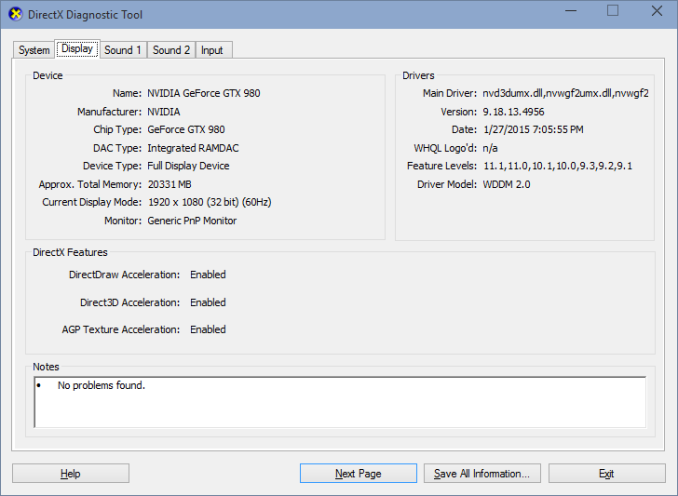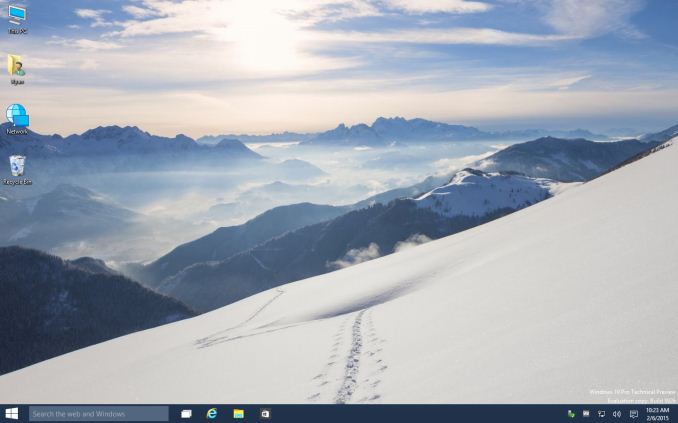The DirectX 12 Performance Preview: AMD, NVIDIA, & Star Swarm
by Ryan Smith on February 6, 2015 2:00 PM EST- Posted in
- GPUs
- AMD
- Microsoft
- NVIDIA
- DirectX 12
The Current State of DirectX 12 & WDDM 2.0
Although DirectX 12 is up and running in the latest public release of Windows 10, it and many of its related components are still under development. Windows 10 itself is still feature-incomplete, so what we’re looking at here today doesn’t even qualify as beta software. As a result today’s preview should be taken as just that: an early preview. There are still bugs, and performance and compatibility is subject to change. But as of now everything is far enough along that we can finally get a reasonable look at what DirectX 12 is capable of.
From a technical perspective the DirectX 12 API is just one part of a bigger picture. Like Microsoft’s last couple of DirectX 11 minor version upgrades, DirectX 12 goes hand-in-hand with a new version of the Windows Display Driver Model, WDDM 2.0. In fact WDDM 2.0 is the biggest change to WDDM since the driver model was introduced in Windows Vista, and as a result DirectX 12 itself represents a very large overhaul of the Windows GPU ecosystem.
Top: Radeon R9 290X. Bottom: GeForce GTX 980
Microsoft has not released too many details on WDDM 2.0 so far – more information will be released around GDC 2015 – but WDDM 2.0 is based around enabling DirectX 12, adding the necessary features to the kernel and display drivers in order to support the API above it. Among the features tied to WDDM 2.0 are DX12’s explicit memory management and dynamic resource indexing, both of which wouldn’t have been nearly as performant under WDDM 1.3. WDDM 2.0 is also responsible for some of the baser CPU efficiency optimizations in DX12, such as changes to how memory residency is handled and how DX12 applications can more explicitly control residence.
The overhauling of WDDM for 2.0 means that graphics drivers are impacted as well as the OS, and like Microsoft, NVIDIA and AMD have been preparing for WDDM 2.0 with updated graphics drivers. These drivers are still a work in progress, and as a result not all hardware support is enabled and not all bugs have been worked out.
| DirectX 12 Support Status | ||||
| Current Status | Supported At Launch | |||
| AMD GCN 1.2 (285) | Working | Yes | ||
| AMD GCN 1.1 (290/260 Series) | Working | Yes | ||
| AMD GCN 1.0 (7000/200 Series) | Buggy | Yes | ||
| NVIDIA Maxwell 2 (900 Series) | Working | Yes | ||
| NVIDIA Maxwell 1 (750 Series) | Working | Yes | ||
| NVIDIA Kepler (600/700 Series) | Working | Yes | ||
| NVIDIA Fermi (400/500 Series) | Not Active | Yes | ||
In short, among AMD and NVIDIA their latest products are up and running in WDDM 2.0, but not on all of their earlier products. In AMD’s case GCN 1.0 cards are supported under their WDDM 2.0 driver, but we are encountering texturing issues in Star Swarm that do not occur with GCN 1.1 and later. Meanwhile in NVIDIA’s case, as is common for NVIDIA beta drivers they only ship with support enabled for their newer GPUs – Kepler, Maxwell 1, and Maxwell 2 – with Fermi support disabled. Both AMD and NVIIDA have already committed to supporting DirectX 12 (and by extension WDDM 2.0) on GCN 1.0 and later and Fermi and later respectively, so while we can’t test these products today, they should be working by the time DirectX 12 ships.
Also absent for the moment is a definition for DirectX 12’s Feature Level 12_0 and DirectX 11’s 11_3. Separate from the low-level API itself, DirectX 12 and its high-level counterpart DirectX 11.3 will introduce new rendering features such as volume tiled resources and conservative rasterization. While all of the above listed video cards will support the DirectX 12 low-level API, only the very newest video cards will support FL 12_0, and consequently be fully DX12 compliant on both a feature and API basis. Like so many other aspects of DirectX 12, Microsoft is saving any discussion of feature levels for GDC, at which time we should find out what the final feature requirements will be and which (if any) current cards will fully support FL 12_0.
Finally, with Microsoft’s announcement of their Windows 10 plans last month, Microsoft is also finally clarifying their plans for the deployment of DirectX 12. Because DirectX 12 and WDDM 2.0 are tied at the hip, and by extension tied to Windows 10, DirectX 12 will only be available on Windows 10. Windows 8/8.1 and Windows 7 will not be receiving DirectX 12 support.
| DirectX 12 Supported OSes | ||||
| Will Support DX12? | Required WDDM Version | |||
| Windows 10 | Yes | 2.0 | ||
| Windows 8.1 | No | N/A | ||
| Windows 8 | No | N/A | ||
| Windows 7 | No | N/A | ||
Backporting DirectX 12 to earlier OSes would require backporting WDDM 2.0 as well, which brings with it several issues due to the fact that WDDM 2.0 is a kernel component. Microsoft would either have to compromise on WDDM 2.0 features in order to make it work on these older kernels, or alternatively would have to more radically overhaul these kernels to accommodate the full WDDM 2.0 feature set, the latter of which is a significant engineering task and carries a significant risk of breaking earlier Windows installations. Microsoft has already tried this once before in backporting parts of Direct3D 11.1 and WDDM 1.2 to Windows 7, only to discover that even that smaller-scale project had compatibility problems. A backport of DirectX 12 would in turn be even more problematic.
The bright side of all of this is that with Microsoft’s plans to offer Windows 10 as a free upgrade for Windows 7/8/8.1 users, the issue is largely rendered moot. Though DirectX 12 isn’t being backported, Windows users will instead be able to jump forward for free, so unlike Windows 8 this will not require spending money on a new OS just to gain access to the latest version of DirectX. This in turn is consistent with Microsoft’s overall plans to bring all Windows users up to Windows 10 rather than letting the market get fragmented among different Windows versions (and risk repeating another XP), so the revelation that DirectX 12 will not get backported has largely been expected since Microsoft’s Windows 10 announcement.
Meanwhile we won’t dwell on the subject too much, but DirectX 12 being limited to Windows 10 does open up a window of opportunity for Mantle and OpenGL Next. With Mantle already working on Windows 7/8 and OpenGL Next widely expected to be similarly portable, these APIs will be the only low-level APIs available to earlier Windows users.













245 Comments
View All Comments
dakishimesan - Friday, February 6, 2015 - link
Because DirectX 10 and WDDM 2.0 are tied at the hip, and by extension tied to Windows 10, DirectX 12 will only be available under Windows 10.dakishimesan - Friday, February 6, 2015 - link
PS: great article.FlushedBubblyJock - Sunday, February 15, 2015 - link
First thoughts: R9 290X dx11=8 frames mantle=46 frames TEST= TOTAL FRAUDAlthough the difference there is what AMD told us mantle would do, only in this gigantic liefest is such hilarity achieved.
Another big industry lie-test blubbered out to the sheep at large.
0ldman79 - Monday, February 16, 2015 - link
It looks more like the people that coded that game are not very experienced and have spent far more time optimizing for future API than DX11.Christopher1 - Monday, February 16, 2015 - link
Not necessarily. DX11 no matter how 'optimized' still does not get you as close 'to the metal' as Mantle does. So yes, there can be these kinds of extreme differences in FPS.The_Countess666 - Thursday, February 19, 2015 - link
they are in fact very experienced. but they choose to do the things that previously DX11 bottleneck prevented them from doing in the past.0ldman79 - Saturday, February 21, 2015 - link
That makes sense, still not quite an apples to apples comparison in that situation, though using previously unavailable features on the new API tends to show the differences.The question still remains, will we see similar improvements on the current crop of DX11 games?
I don't think that will be the case, though I could be wrong.
Seems the gains are from multithreading, which is part of the DX11 or 11.1 spec.
RobATiOyP - Sunday, February 21, 2016 - link
Of course you won't see such a performance increase, because games have to be designed and tuned to what the platform is capable of. The console API's have allowed games, lower level access, Mantle, DX12 & Vulkan are about removing a bottleneck caused by the assumptions in DX11 & OpenGL API's which were designed when GPUs were novel items and much evolution has occured since. Those doubting the benchmark, please say why a graphics application would not want to do more draw calls per second!Fishymachine - Monday, February 16, 2015 - link
DX11 can manage up 10k draw calls, Star Storms makes 100k. Also Assasins Creed Unity makes up to 50k in case you wanted a retail game that would skyrocket in low API(there's a spot where even 2 GTX980 get 17fps)The_Countess666 - Thursday, February 19, 2015 - link
this engine was spefiically written to do all the things that previously DX11 doesn't allow game developers to do. it was designed to run headlong into every bottleneck that DX11 has.it is in fact a great demonstrations of the weaknesses of DX11.
the fact that nvidia gets higher framerates in dx11 then ATI is because they optimized the hell out of this game. that isn't viable (costs too much, far too time consuming) for every game and was purely done by nvidia for marketing, but all it really does is further illustrate the need for a low level API where the burden of optimizations is shifted to the game engine developers where it belongs, not the driver developers.